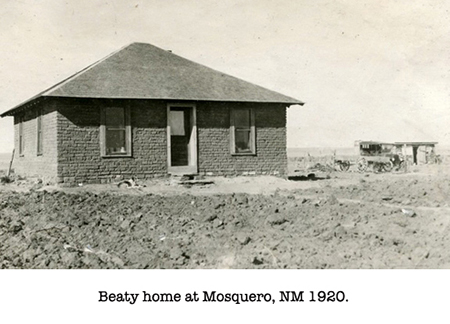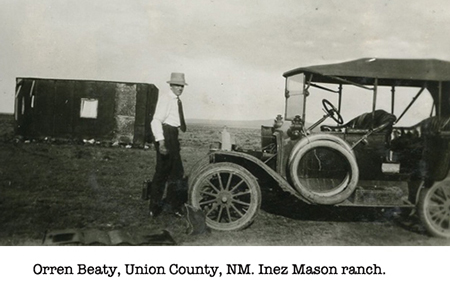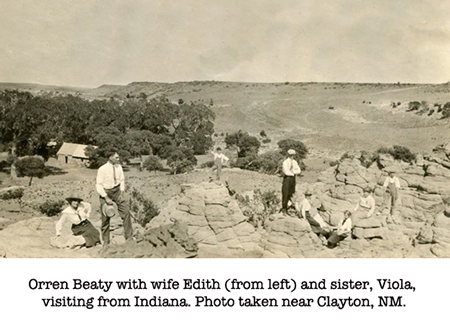Early Days in Union-Harding Counties
On June 1, 1916, I landed in New Mexico to take up County Agent's work in Union County. I employed the major part of my time the first few months in getting acquainted with the different communities of the county and seeing what kind of farming was being done. I was anxious to learn what crops were being grown in the county and which ones should be stressed. In due time, I reached Mosquero in the southern part of the county. In talking to Benjamin Franklin Brown, a lawyer, real estate agent and part-time hotel keeper, I learned that at Black Lake, six miles northeast of town, alfalfa was being grown by dry farming practice. The water table being not too far from the surface, the alfalfa made good growth. I immediately made a trip out to see Homer McKenzie, who had alfalfa growing, and it had been doing fairly well for five or six years.
Just across the road from Mr. McKenzie's place was a school section of land that sloped to the edge of the lake on the north side. At different times I had studied that land and felt that it offered a good opportunity as an investment. Mr. Brown said it could be put up for sale by paying so much down and having the State Land Office fix a date for sale. I had to pay one dollar per acre down to get the sale started; that meant $640 to put into the venture. At the date of the sale, if no one bid against me, I could buy it for $10 per acre. No one bid against me and I made the purchase in 1918 or 1919.

From then on, I kept buying cattle, horses and pigs. Mr. Plunkett, a rancher north of Clayton on the Corrumpa, gave me three orphaned lambs that were raised on the bottle. The place was not fenced and there were no buildings on it. In 1919, I hired Judge McLaughlin, who lived near the place, to build a wire fence around the section and to hire thirty acres of sod-land broken.
After living in Clayton for nearly two years and after being married a year (Edith Mason and I were married May 5, 1917), we rented the Robert Isaac's house and land a mile north of Clayton. In renting the place we bought a large number of hogs from the former renter. From then on I bought horses and cows and farm equipment and kept them on the Isaac's ranch. On April 3, 1920, I resigned my position as County Agent and moved to Mosquero. We moved into a house on the farm adjoining our place while we were having a house built.
I first moved our furniture, tools and livestock and Edith came later with Orren, Jr. and the rest of our goods. To move the furniture, farm equipment and livestock, I purchased a team of draft mares, Dolly and Topsy, with lumber wagon and harness. I also hired a boy with a saddle horse to drive the livestock.
The first day was the worst of the trip with the horses trying to take off in other directions and the cows and sheep going another. We wore the saddle horse out the first day and it went lame. The second day, I tried something else. I let the boy drive the team and I followed the livestock on foot. I got my pockets full of rocks and whenever any of the livestock started to stray, I would yell at them and hit them with a stone. By the end of that day we had no trouble with the animals straying.
The first night we got to Tom Gray's ranch near the Pennington Post Office. Tom Gray was an early sheriff in Union County and had helped round up Black Jack Ketchum. He was a cousin of Mrs. Jack Herd of Lea County. He had me turn the livestock in his corrals and fed them all. He took the boy and myself into his home, fed and gave us a bed for the night: true Western hospitality. He would not let me pay for anything and made me feel welcome.
The next night I reached some friends' home near Pasamonte, Dr. and Mrs. John Ivey and son. That night it started to rain. We unloaded the furniture into a dugout and turned Dolly and Topsy in the pasture. I sent the boy and saddle horse back to Clayton and started on alone and afoot with the livestock. I still had about sixty miles to go across pastures all the way to the Black Lake ranch. I found lodging and corrals each night and a bed and food for myself. I had no trouble keeping the livestock together and reached the ranch the fifth day from Clayton. Edith and Orren, Jr. arrived the next day with the Ford. We drove the car back to Ivey's where the furniture was stored.

Edith and Orren, Jr. left me and went back to the ranch where they stayed with neighbors. I loaded up the furniture and started for the ranch and got there the third day.
We moved into the vacant house on the adjoining ranch where we lived while our house was being built. The livestock was turned in on the 640 acres of grass and we would drive the car to where they were grazing and milk them. They were gentle and would let us milk them anywhere. I had a well drilled where we had started to build and got a good well the first day at about forty feet deep.
I had hired Mexicans to make and lay the adobes for $30 a thousand and the walls were up when we arrived. I had hired a carpenter to finish the house while I helped Judge McLaughlin harvest his wheat crop. The carpenter did not start work for some time and we had several heavy rains. One day the carpenter came to where I was stacking wheat and said that the rain had wrecked the walls and that they would have to be torn down and relaid.
I went with them to see what could be done and found the north wall leaning and broken free from the corner of the east wall. I told the carpenter to put a brace against the north wall. Then we shoved the wall back in place and braced it so it could not break loose. Then I had him make it more safe by plates of timber around the top of the wall. It held and the house was soon finished I have always thought the carpenter was sorry we did not have to tear the walls down. There were a few of the settlers who thought I had lots of money and enjoyed everything that went wrong on the place. As a whole, we had wonderful neighbors and they have remained friends to this day. After harvest, I bought rocks from a deserted Mexican building and hauled them home to use in building a hen house and shed for the cows and horses. Then I laid the rocks and built a hen house and the cow shed. I mixed mud to lay the rocks in the walls and made a corrugated tin roof for both buildings.
During the fall of 1920, Judge McLaughlin, who had been nominated to run for State Representative at the county meeting, withdrew from the race. The County Democratic Committee chairman drafted me to fill in. I told them I would not run as I had no money to spend in making a canvass of the county. They promised to pay all expenses if I would run. The Republican Party had nominated Ray Sutton, the present sheriff, to run for that office. I finally made the decision to run and with the Democratic people running for office, visited every community in the county. It was the year when the U.S. went solidly Republican. Only four or five Democrats won in the November election and I won by 37 votes. We did not take office until January, 1921.
After the election, I worked at finishing the buildings, putting up corrals and getting things ready for winter. We had no grain for the poultry and livestock so Edith and I bought a field of milo and every nice day we headed milo and got enough grain to feed through the winter. While we worked in the field we left Orren, Jr. with the William Pittman family.
The first of January, I went to Santa Fe to attend the legislature. I found rooms and sent for Edith and Orren, Jr. to come down and we lived there during the session of the Legislature.
It was at this session that Harding County was created with Mosquero as the county seat. We enjoyed our stay in Santa Fe, made a lot of friends and visited points of interest in the city. Senator T. E. Mitchell introduced the bill in the Senate and I in the House for creating Harding County. We were very popular when we returned home and a county-wide meeting was held to celebrate the occasion.
After the legislature adjourned, we returned home and I started breaking more land for crops and alfalfa. In all, I broke about forty acres of sod and planted it to grain sorghums, cane and beans.
During the spring we decided to consolidate the three school districts in that section of the county and bring all the kids to Mosquero for schooling. It was a hard fight but we won out. When school was out in May, the school board elected me principal of the school for the next term.
During the spring of 1921, I planted about thirty acres of grain sorghum, cane and beans and ten acres of alfalfa. I built a fence around ten acres of land for the sheep and hogs. By this time our sheep had increased to six or eight head. The names of the three original sheep were Nannie, Tootsie and Buck.
Our crops did exceptionally well and we had feed to last the livestock for three years. The bean crop was a life saver as the panic of 1921 started then and we could not sell anything to live on except the beans, cream and eggs. Livestock prices fell and horses I had paid $150 to $200 for were worth $20 and $25 and cows the same.
We had our own meat, eggs, milk, butter and beans so our groceries were not too costly. Our wheat crop was very good until rust hit it and we made very little from it. That fall, about twenty very good Hereford cows were offered to me for $20 a head. I thought they could go no lower, so I bought them. I let them run on our pasture all winter and sold them for just enough more than I paid for them to buy me a suit of clothes, but I had their company for several months.
When school opened the first of September, I started teaching and taught the 7th, 8th and 9th grades and was in charge of the school. I did not have a license to teach but the school superintendent gave me an examination in New Mexico history and civics and I passed. [I have found a State Elementary Certificate, First Grade, issued to Orren Beatty, Sept. 1, 1922 by the State Superintendent of Public Instruction -- it is in a folder of very old diplomas, etc. in a storage box in the basement - OWB 10/25/1971] (When Harding County was created, Governor Edwin Mechem appointed T. E. Mitchell's daughter to be County School Superintendent.) She was Senator Mitchell's daughter and had a boy and girl in the Roy School.
She visited my room one day while I was working and explaining an algebra problem on the blackboard. At recess time she told me she had never had a problem explained so well and that she liked the way the school was being conducted. She said she was going to transfer her children to Mosquero school, which she did. During the spring I was offered the job of County Agent in Lea County and accepted. I did not tell the school board about it as there was a fight on to keep them from rehiring me. However, the board rehired me and then I resigned so they could hire someone else.
On February 3, 1922, Billie was born. Edith's mother was living on their claim northwest of Clayton where she had to haul water and wood. We offered her the house to live in and the returns from milk cows and poultry when we left for Lovington. She accepted and moved down the last of May.
She stayed there two years and decided to move back to Clayton. When she left the place, they had arranged for the family of John Linson to move in and look after the livestock and place. He and his family were the lowest of the poor white trash and he was a liar and a thief in addition. My cows began to disappear and the house was a wreck and filled with bedbugs.

To protect our interest, I decided to have a sale and sell off everything. In the meantime, I sold the ranch to Mr. Brock, the Mosquero postmaster. At the sale, the livestock sold at very low prices as the panic was still on. I got about an average of $30 for the horses and cows. The furniture left in the house was so dirty and torn up that we just left it there. Mr. Brock reworked the inside of the house to get rid of the bedbugs, built walls for the rooms and built a house for workers. He spent too much on improvements and could not pay for the ranch and turned it back to me. In fact, he had gotten in trouble in the post office affairs, or so most people thought, and committed suicide a few months later. I then sold the place to Elmer McDaniels who still owns it.
We moved to Lovington on July 1, 1922, and lived there until June of 1936.
It would be a mistake to end this story without giving an account of our life in the Mosquero community. The first Sunday there, we attended church at the community church where we met many of our neighbors-to-be. When church was over, Mr. and Mrs. A. W. Drake invited us to their home for dinner and such a wonderful dinner we had. Every Sunday some family would have us in for dinner until we had been guests in many of their homes. Some of our closest friends and neighbors were Judge McLaughlin and wife; Mr. and Mrs. W. T. Pittman; J. U. Tobler and family; Mr. and Mrs. W. T. Lofton; Judge and Mrs. Smith and family; Mr. and Mrs. Brock; Tony and Katherine Heimann, a newly-married couple; and several others whose names I cannot recall.
With all of these folks we worked to secure a new county and county courthouse, a consolidated school district and a new high school building. We held many family meetings where we had dinner together and where we formed plans for securing the different things we needed for the advancement of our community and county. We never lived in a more friendly and cooperative community. Our two years in that community were two of the happiest years of our lives and also the two years of hardest work. We worked from early morning until late in the evening in order to establish a home. During the school year, I milked six cows and did the chores before starting for school, six and one-half miles away; then I'd do them again after I got home from school. I received $100 a month for teaching, which I was very proud to get.
Edith was a big help and took care of the place in my absence. She and Billie were not too well as the high altitude (over 6,000 feet) did not agree with them. When we moved to Lea County and a lower altitude, they both felt much better.
The story of our life on the Black Lake ranch would not be complete if we left out Pinto Perro. Before we left for the ranch, Mr. Willis Plunket gave us a shepherd pup that was six or seven months old. He was Orren, Jr.'s guard and pal. He would go everywhere Orren, Jr. wandered in play, and if any livestock was near the house he always kept between Orren and the livestock. He was a good watchdog, too, and always let us know if anyone was near. After I bought the twenty Herefords, we had quite a herd of cattle. One day I went to drive them to the corral and found them divided into two bunches. I started one bunch toward the corral and told Pinto Perro to go drive the other bunch in. Without any previous training he went and drove the other bunch in.
He was left on the ranch when we moved to Lovington and Mrs. Mason and the girls made a great pet of him. When they moved back to Clayton, we took him with us to Lovington. However, he was not a town dog and in a short time he left us. We did not see him again for a month or more, when one day he came back. He stayed a few days and then left again, never to return. The children were heart-broken when he left.